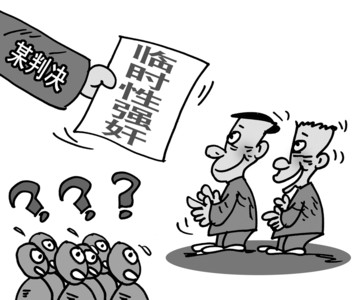Apparently, lesbians in China are less threatening. But less threatening than what? Lalas, the Chinese equivalent of lesbian, are less threatening to conceptions of gender and sexuality than gay men.
Lalas are apparently less threatening because the government has approved a reproduction of a 19th century play featuring two women who fall in love with each. Such approval does not confer acceptance. Just ask the organizers of a recent gay pageant. They had permission, but the police shut it down. Ask the organizers of the Beijing Queer film festival. For years, they would get the necessary permits only to have them eventually revoked.
According to Eli Zaretsky, a psychoanalytic historian of Capitalism, contemporary sexual identities are rooted in corporate Capitalism and the corresponding rise of “personal life,” that is, sections of life that are not connected to the production of value. As far as those interests are concerned, what you might do in your free time does not matter as long as you continue to produce value – which can be generated either through labor or consumption. This represents a rupture from earlier methodologies, which sought to control every aspect of the worker’s life in order to achieve maximum productivity.
Deregulated identities are not unregulated identities. It is simply cheaper for people to internalize regulations and enforce the ethic themselves. The contradiction between prevailing cultural norms and the interests of Capitalism forms the boundary that separates personal life from production. An identity too far from what is deemed acceptable cannot produce and thus cannot consume. An example of this can be found in a recent survey conducted in the US, in which 6,450 transgender identified individuals found “near universal harassment on the job.” This assumes, of course, that they could even find a job.
While certain identities may have been able to distance themselves from the requirements of productivity, there has been nowhere near the same success in the realm of reproduction. Indeed many of the Chinese queer economies of desire seem to be defined almost exclusively through heteronormative means.
Lala couples are expected to be comprised of a “T” and a “P.” “T” stands for the adopted English term ‘tomboy’ while “P” is a derivation of laopo, or wife. T is supposed to be more masculine in presentation and thus to take a more active sexual role. P is expected to exist through her femininity and passivity. In this particular economy of desire, a feminine identity is the most sought after.
While there may be a hierarchy of desire amongst lalas, their spaces are not subject to extreme regulations of desire and presentation that seems to be present within the gay male, also known as tongzhi, communities. There, men who display any form of femininity are immediately ostracized as being “not right”. Most will reply that this is because they want to be with men who act like “real” men. Of course, if they really wanted to act like “proper” men they would sleep with women. While the prevalent position on “feminine” men is mired in misogyny, it is also a reaction against a larger cultural misogyny that would feminize and ostracize them simply because to be attracted to a man is to be automatically feminized.
This same ideology carries through what in the U.S. would be called transgender identities. (I refer here only to trans-women as I have no experience with Chinese trans-men.) Their extreme marginalization makes these liminal identities even more resistant to reductive and categorical definition. The difficulty of definition is compounded by the fact that there does not seem to be any sense of cohesive community. Some might secure employment in a legitimate hair salon. Others find work as drag queens. Or they might be self employed, going to popular clubs looking for `foreign investment’. In the case of the last two, any revenue depends on their status as male-bodied women.
One such woman told me that if she were to really be a woman she would have to kill herself, because, otherwise, she would be excommunicated from the collective tongzhi, who already mistrusted her. On the other side, she could never tell her future husband of her past for fear that he would leave her. Not all feel exactly this way, but all distinctly feel the contradiction between their desires and their realities. And so they do what they can, (re)claiming spaces of resistance wherever they are able.
None of this is to say that their desires or their genders do not reflect authentic positions, only that they also reflect social expectations. To this end each identity is defined by the politics of “passing,” being perceived as belonging to the dominant (i.e. heterosexual) group. Gender presentation or identity aside, they are all able to achieve this social ideal through reproduction. Most talk of marriage as a shield from stigma. The difference is that this shield comes in the form of a performance of heterosexuality through the production of a child – a commodity all the more imperative to produce since the advent of the one child policy.
While Capitalist ideology may have opened the space needed to express these identities, it brought with it the imperialism of queer identities native to an English-speaking world. Often, these identities impose categories on the way that these other identities are supposed to behave and how they are supposed to work within the global framework of reclaiming gender diversity from colonialism.
Nevertheless, these are identities struggling to create authentic spaces of existence. That the lalas are somehow less threatening is ridiculous. Even though their identities may fit within the heteronormative paradigm, the space is still subverted through the reclamation of gender diversity. The master’s tool may not be able to completely dismantle the structures of oppression, but his sledgehammer might still be useful to knock down a few of the walls.


